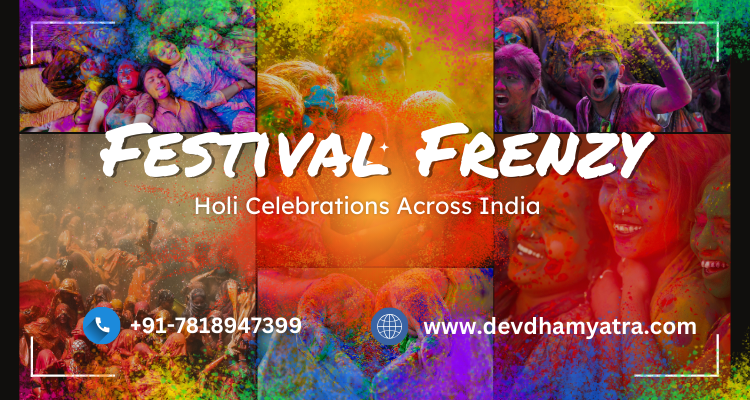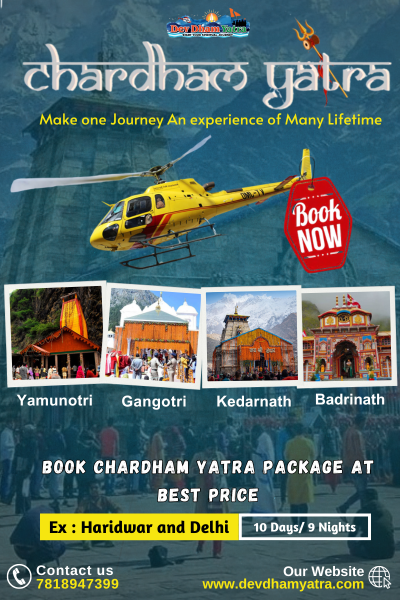Holi festival is the Festival of Colors. It marks the arrival of spring, the season of love, and the triumph of good over evil. The Holi festival usually falls in the Hindu calendar month of Phalgun, typically in March.
The beauty of Holi lies in its colorful rituals and traditions. The night before the main celebration, people gather for Holika Dahan, where bonfires are lit to symbolize the burning of Holika, the demoness, and the victory of good over evil. This ritual signifies the legend of Prahlad and his devotion to Lord Vishnu, which saved him from the clutches of his evil father, King Hiranyakashipu.
The real fun of Holi begins on the morning of the main day, when people come together irrespective of caste, creed, or status, to play with colors. Bright-colored powders, known as “gulal” and colored water, are playfully splashed and smeared on each other’s faces, making the entire atmosphere vibrant and joyful. It’s a time when social barriers are broken, and the spirit of unity and brotherhood prevails.
Music, dance, and delicious food are integral parts of Holi celebrations. Traditional sweets like gujiya and thandai, a special drink made with milk, nuts, and spices, are savored during the festivities. In some regions, people also enjoy folk dances like the dandiya and the energetic beats of the dhol (drum). Beyond its cultural and religious significance, Holi has transcended boundaries and become a symbol of spreading love, happiness, and harmony. It is celebrated with great enthusiasm by people of all ages.
Different types of Holi
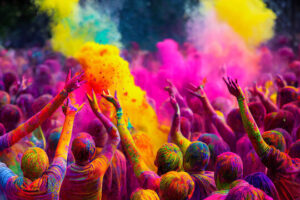
1.Laddoo Holi – Barsana

Laddoo Holi is celebrated in the Radha-Rani temple of Barsana. This temple is also known as Shri Ji Mandir. According to a folktale, Lord Krishna, with his friends used to visit Barsana and playfully tease Radha and her friends. In reaction to this, Radha and the gopis of Barsana would chase Krishna and his friends away by throwing laddoos at them.
Laddoo Holi in Barsana is not only a fun-filled event but also a symbol of the playful and flirtatious nature of love. It brings communities together, strengthens bonds, and adds a touch of sweetness to the Holi festivities. The colorful spectacle of flying laddoos and the jovial spirit of the participants make Laddoo Holi in Barsana an unforgettable experience.
2. Lathmaar Holi – Barsana
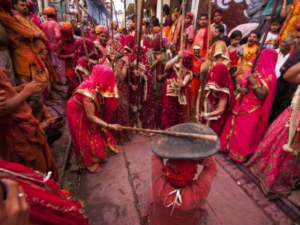
In this tradition, women from Barsana greet men by beating them with a stick. Men in return, try to protect themselves with shields. This act is completely for entertainment purposes. The surroundings are filled with laughter, cheers, and a friendly atmosphere.
3. Phoolon ki Holi: Vrindavan and Mathura
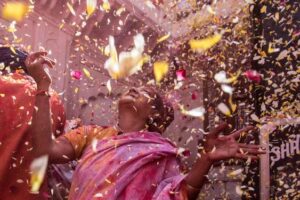
Phoolon ki Holi festival is also known as the “Holi of Flowers”.During Phoolon ki Holi, the streets and temples are decorated with vibrant flowers. Marigolds, roses, jasmine, and other fragrant flowers are used to create stunning garlands and floral arrangements. In this celebration, people play Holi with a variety of beautiful flowers and throw flower petals on each other instead of powder colors.
4. Vidhwa Holi: Vrindavan

Vidhwa Holi is also known as Widows’ Holi. This unique celebration takes place in the historic city of Lord Krishna where he is believed to have spent his childhood. Many widows who are abandoned by their families, find solace and reside in the ashrams (religious retreats) dedicated to Lord Krishna. During Vidhwa Holi, these widows gather in the ancient temples and ashrams of Vrindavan to celebrate the festival of colors.
It is a means of reclaiming joy and dignity in their lives. It challenges social stigmas and stereotypes surrounding widowhood and empowers these women to embrace their identity with pride and dignity. Vidhwa Holi in Vrindavan is a touching and meaningful expression of faith, compassion, and the enduring spirit of human resilience.
5. Holi of Powdered Colours: Mathura

This is an extraordinary and fun-filled method of celebrating Holi festival. People throw colors and water at each other. Various delicious delicacies are prepared like Gujias, ladoos, chat papadi etc. People gather together and meet and greet with each other to celebrate the victory of good over evil.
6. Huranga Holi: Baldev
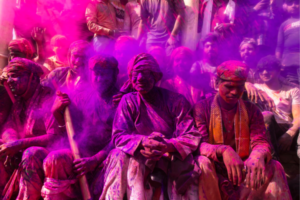
Baldev is a village that is 30 km away from Mathura. During the Huranga Holi in Baldev village, men and women chase each other through the streets. The atmosphere is filled with laughter, music, and the vibrant colors of powdered dyes, creating a joyful spirit. Huranga Holi festival is celebrated a day after the main Holi festival. It is a high-spirited game where women playfully drench men with colored water and tear their clothes, and chase them to beat with sticks.
Holi festival is a time for communities to come together and break down their social barriers to celebrate the spirit of togetherness. Music, dance, and delicious food are integral parts of Holi celebrations. Traditional sweets like gujiya and thandai, a special drink made with milk, nuts, and spices, are savored during the festivities.
Bright-colored powders, known as “gulal” and colored water, are playfully splashed and smeared on each other’s faces, making the entire atmosphere vibrant and joyful. It is a time when people come together to forget their differences. Holi celebration offers a refreshing break from the stressful and monotonous life. colors during Holi not only paint the surroundings but also hearts with love and compassion, fostering a sense of togetherness among people.
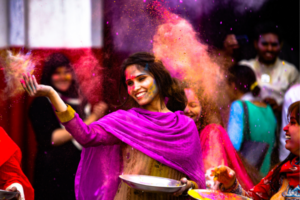
Frequently Asked Questions: FAQ’S
1. Which is the popular drink of the Holi festival?
A special drink called Thandai, made with milk, nuts, and spices, is prepared in this Holi festival. Some people add “Bhang” in this drink. Which is also a popular variant of this drink.
2. When is Holi celebrated according to the Hindu calendar?
Holi festival is the Festival of Colors. It marks the arrival of spring, the season of love, and the triumph of good over evil. The Holi festival usually falls in the Hindu calendar month of Phalgun, typically in March.
3. Who was Holika?
Holika was the sister of a demon king known as Hiranyakashyipu. She had a boon that she could not get burnt into the fire. Holika took negative advantage of this boon and wanted to kill Hiranyakashyipu’s son, Prahlad, because Prahlad was a great devotee of lord Vishnu.

